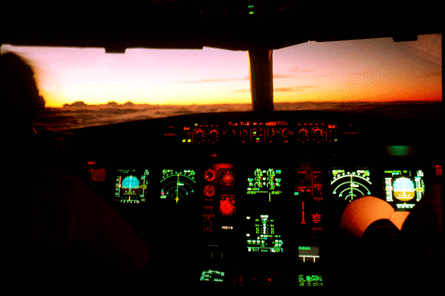Scandinavian Airlines is at the forefront of a project to perfect continuous descent approaches by airliners to cut fuel use and pollution
Scandinavian Airlines in early December completed Europe's first ever commercial transatlantic "green approach", designed to reduce significantly the amount of fuel used during arrival and landing.
The flight was part of a programme in which all SAS Airbus A330 flights inbound to Arlanda, Sweden between 1 December through to 6 January were earmarked as "Aurora" arrivals.
Aurora is a project run by Airbus, the Swedish CAA and SAS, the results of which are intended to quantify flight management system performance and predictions when conducting continuous descent approaches (CDA) to Stockholm Arlanda. Much of the work involved relates directly to previous trials with SAS's Boeing 737 fleet as part of the European Union's North European ADS-B Network Update Project (NUP) 2+, which is an extended second phase of NUP.

All findings from the trials will contribute to the future development of air traffic management systems in Europe under the SESAR Single European Sky initiative.
While performing a CDA - essentially an optimized landing approach where an aircraft flies a continuous and uninterrupted descent at idle power from cruise altitude to the runway - is not rocket science, SAS was realistic about the number of flights that would actually be able to complete them.
In more than 1,300 green approaches, SAS has already recorded average fuel savings of 186kg, a CO2 reduction of 315kg, and a NOx reduction of 0.011kg per arrival. Congestion remains a significant complication. SAS therefore knew it was not guaranteed to obtain complete CDAs in peak weekday periods at Arlanda airport, although the airline did aim to achieve high levels at weekends.
Even so, A330 pilots were requested to plan for a full CDA with RNAV for each arrival, but to remain flexible and revert to air traffic control if congestion did not allow a CDA. ATC did, however, undertake to leave pilots untouched to at least the ELTOK/XILAN terminal area entry waypoint.
The intention was to fly the aircraft with autopilot engaged and autothrottle on with managed modes engaged from the end of cruise up to as far as practical on the approach so as to quantify the benefits of an idle-power descent including fuel, emissions, noise, track miles and time savings. It also aimed to identify the constraints of idle descent in terms of ATC tune current idle descent procedures to maximise benefits understand flight management system behaviour and assess performance in terms of time predictions and altitude optimisation.
A further objective was to assess improvements to be used in the flight management system and in a future ATM structure and to assess the gains with better wind knowledge and to develop wind data uplink solutions.
Data collection was both automatic using the aircraft condition monitoring system and by using ADS via Airbus in Toulouse, which was tracking the flight, as well as manual records kept by the crew. Radar plots were also used. The procedures required printed copies of wind data and flight plans. All hard copies were inserted into a sealed envelope with crew anonymity guaranteed.
Busy Friday
Using a single left engine to taxi the 1.5km to the parking stand, SAS flight SK904 took off at 18.23h local time on a hectic Friday at New York's Newark Liberty International airport. SK904 avoided the busy organised track system as SAS transatlantic flights need only run parallel to the most northerly of these before being able to divert even further north on a random track allowing for route optimisation. Strong tailwinds allowed a more southerly routing, however, which reduced estimated flying time.
Wind prediction data supplied by the UK Meteorological Office was fed into the aircraft's flight management system. While forecast winds are used for most of these flights, Airbus is interested in evaluating a tool generating actual winds - so called "nowcast" winds.
Here, forecasts are continually refined based on feedback from observed winds recorded by SAS Boeing 737s flying into Arlanda and downlinked to a database before being uplinked to following aircraft. The objective is to quantify the differences between forecast winds, nowcast winds and actual observed winds. At the moment when SK904's crew requested descent winds data during the flight, the difference between nowcast and actual winds was only 4kt.
"Helping to refine predictions in the flight management system forms one of the important elements of SESAR," says says Sigmund Lockert, SAS's Airbus A330/A340 fleet chief pilot and first officer on the flight. "Essentially we want to assess the differences between forecast wind data and nowcast indications to improve the accuracy of forecasts. Ongoing efforts here could determine much more accurately the most efficient cruise altitude depending on prevailing wind conditions."
Precise arrival routing
Another innovative feature of the flight management system is that it automatically sends an "off message" to the specially modified Arlanda ground system, allowing the ground to know the estimated time of arrival up to 90min in advance before uplinking a precise arrival routing.
At 325km (175nm) before estimated touchdown, the engines retarted to idle and in theory should have remained at idle until touchdown with the flight management system flying the whole procedure, levelling off at 2,500ft (760m) before intercepting the glidescope 9.4nm from Arlanda.
The aircraft remained exactly on profile and speed and in idle power although, shortly after "green dot" speed was reached, a little power kicked in only to resume idle mode at 220kt, caused probably by low pressure. After landing and shutting down one engine, SAS flight SK904, carrying 260 passengers from Newark to Stockholm, reached the Arlanda terminal building at precisely its 06.24h estimated time of arrival. A second CDA test period is scheduled to start on 1 March.
Source: Flight International

















